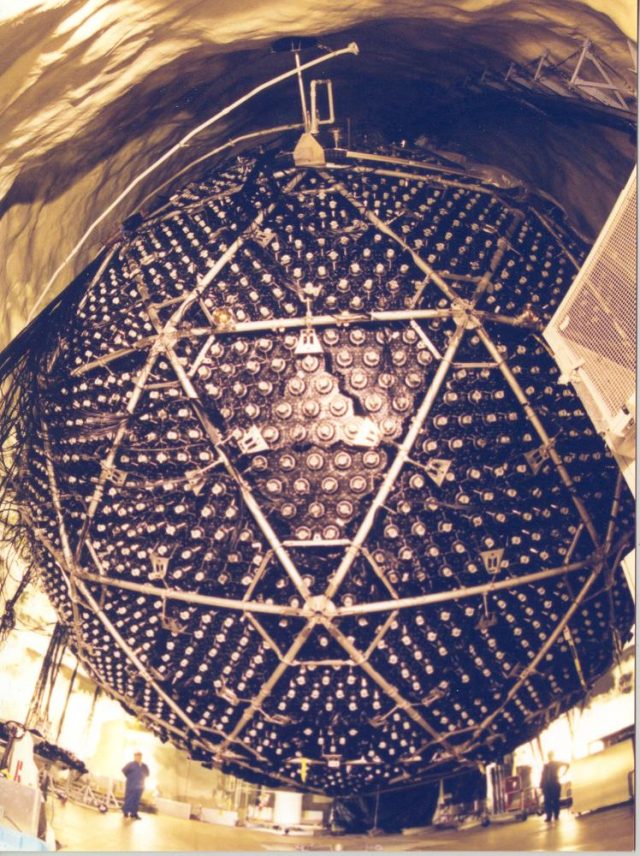

We highlight that at present, PMT dark rate and event reconstruction algorithms are the limiting factors to extending beyond ~50-kt fiducial mass. We calculate the detector run time required to detect a small 50-MWt reactor at a variety of stand-off distances as a function of detector size. Realistic background models for the worldwide reactor flux, geo-neutrinos, cosmogenic fast neutrons, and detector-associated backgrounds are included. In this paper, we focus on the reactor discovery potential of large-volume Gd-doped water-Cherenkov detectors for nuclear nonproliferation applications. Even though Cherenkov emission does not produce many photons and the energy resolution is poor, there may be a place for Gd-doped water detectors for the largest of far-field detectors. Gadolinium-doped water-Cherenkov detectors have been proposed for very large reactor monitoring detectors. If the detector is so large that photons cannot traverse across the detector medium to an optical detector, then it becomes impractical. So large in fact that the optical opacity of the detection medium itself becomes an important factor. But to detect or rule out the existence of a single small reactor over many km requires a large detector. The kton-scale KamLAND experiment has demonstrated the capability to detect reactor antineutrinos at few-hundred-km range. McDonald, director of the Sudbury Neutrino Observatory, won the 2015 Nobel Prize in Physics.Antineutrinos are an unavoidable byproduct of the fission process. They also have demonstrated that neutrinos do have a mass, and for this major discovery Arthur B. The results from the Sudbury Neutrino Observatory have demonstrated that neutrinos do indeed change their form during their trip from the Sun to the Earth, thus putting an end to the debate. The frequency of neutrino detection is one per hour. The acrylic vessel is surrounded by a 17-metre geodesic dome equipped with 9,600 detectors that sense the presence of neutrinos. It is the largest underground opening ever excavated at two kilometres depth. The vessel is itself enclosed in 7,000 tonnes of ultra pure normal water, lodged in an immense cavity measuring 22 metres wide and 34 metres high (the equivalent of a 10-storey building). The detector consists of 1,000 tonnes of ultra pure heavy water enclosed in a transparent plastic vessel measuring 12 metres across. Work began in 1990 and was completed in 1999. The United States joined the project, follow by the United Kingdom in 1989. Since Canada has an abundant reserve of heavy water, it was decided that the facility would operate as a heavy water detector. One year later, in 1984, an American researcher published a study that demonstrated the advantages of using heavy water (water in which the hydrogen atoms each have an extra neutron) as a neutrino detector. The underground site would shield the detector from microwaves in the background cosmic radiation, which would normally impede the detection of solar neutrinos. In 1983, Canadian researchers proposed the construction of an underground neutrino detector in an Ontario nickel mine belonging to the company Inco. In the early 1980’s, it was realized that the number of solar neutrinos detected by various laboratories were less than predicted by theoretical calculations. One of the major unresolved problems about our Sun is related to its production of neutrinos. In fact, during your entire lifetime, only one or two neutrinos will ever come into contact with one of the atoms in your body. Billions of neutrinos pass through the Sun, the Earth and your body every instant without being hindered. The Sun, for example, emits 200 trillion trillion trillion neutrinos each second. Stars produce large amounts of neutrinos. So little, in fact, that matter is virtually transparent to them, and therein lies the difficulty in detecting neutrinos. Neutrinos are small elementary particles that are electrically neutral (that is, they have no electrical charge). It is the product of a collaborative effort between Canada, the United States, and the United Kingdom.

The goal of the observatory is to detect and study neutrinos emitted by the Sun and other celestial objects. The Sudbury Neutrino Observatory began operating in 1999 at a depth of 2,070 metres below the surface in the Creighton mine near Sudbury, Ontario.


 0 kommentar(er)
0 kommentar(er)
